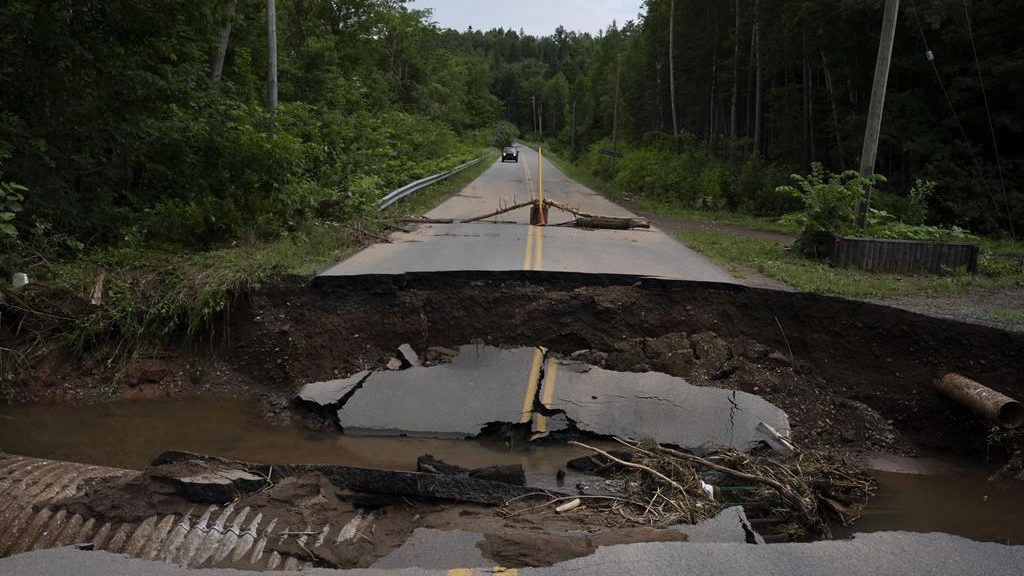Use of alert system delayed during deadly flash flooding in Nova Scotia: Report

Posted May 14, 2024 04:03:17 PM.
Last Updated May 15, 2024 11:52:03 AM.
A new report on flash flooding in Nova Scotia that killed three children and one adult last year says the municipality of West Hants faced several challenges in transmitting timely emergency alerts to the public.
The after-action review says that on July 22, 2023, fire departments started receiving emergency calls at 12:25 a.m. reporting that many people were stranded by floodwaters fed by severe thunderstorms that dumped up to 258 millimetres of rain on the rural area northwest of Halifax.
Within the next hour, the deputy chief of the Brooklyn Fire Department used a two-way radio to ask the local 911 dispatch service to get the RCMP to issue an alert, and the fire chief also texted the West Hants emergency management coordinator to request help with an alert.
But almost two hours would pass before a “shelter in place” alert, using the Alert Ready system, was sent to some wireless devices, as well as to radio and TV stations serving the area.
The report, prepared by the West Hants emergency management co-ordinator, says poor cellphone service was partly to blame for the delay, as was the fact that not all cellphones were equipped to receive such messages. The report says the alerts can only be received by phones using LTE networks or more advanced systems.
As well, the report says some residents received the alerts in the wrong order and that one of the alerts sent that morning — warning that a dam might overflow — was repeated the next day, creating confusion.
Blair Feltmate, head of the Intact Centre on Climate Adaptation at the University of Waterloo, said a report on flood risks prepared by the centre in 2020 gave Nova Scotia a poor grade on its efforts to maintain communications between emergency responders and the public during major rainfall events.
During the 2023 floods, “this breakdown in communications proved lethal,” Feltmate said in an email. “A near three-hour delay between the time the fire department began receiving emergency calls … and a subsequent alert to shelter in place that was issued shortly after 3 a.m. is far too long a delay.”
Two six-year-old children, a 52-year-old man and a 14-year-old girl died after they were swept away as waters poured onto a rural highway near Brooklyn, N.S., on the morning of July 22.
Feltmate said the centre’s key findings about Nova Scotia’s deficiencies were well documented by the media.
“Hopefully, the lessons of the new West Hants report are not forgotten or ignored once again,” he said.
Abraham Zebian, mayor of West Hants, could not be reached for comment. He and other members of council were expected to discuss the municipal review Tuesday night.
Local resident Amanda Dunfield said the review does a good job of identifying challenges, but she said the municipality has fallen short when it comes to addressing the public’s concerns.
“It was a bit of a gloss-over,” said Dunfield, a former paramedic and medical communications officer who lives in Windsor, N.S. “Most of the community is saying there’s been a lot of talk, but we’re not seeing things done.”
Among other things, Dunfield said the region’s emergency plan hasn’t been updated since September 2021, even though it’s supposed to be updated annually. She said the municipality’s emergency measures coordinator should be employed full-time rather than part-time. And she urged municipal officials to use social media and the region’s website to rebuild trust with the community.
In response to its own review, the municipality says in the report it has acquired some satellite telephones and advanced two-way radios to deal with future cellphone outages.
It has drafted templates to speed up the creation of Alert Ready messages and saved alert request forms on desktop computers to ensure they are accessible when the internet is down. As well, the municipality says the number of staffers who can approve Alert Ready messages has been increased.
On another front, the report says there was virtually no internet or cellular network connectivity after the thunderstorms arrived, which made it impossible to access online flood maps that could have been used by the public to assess the risks. As a result, West Hants has acquired the Starlink satellite-based internet service to maintain internet connectivity during emergencies.
Feltmate said Nova Scotia remains the only province in Atlantic Canada that delegates responsibility for floodplain mapping to local governments.
“Delegating flood risk authority to municipalities was a grave error on the part of the Nova Scotia provincial government,” he said. “Local governments often do not have the background, training and resources to limit flood risk. In July 2023, in West Hants, we saw the worst consequences of poor flood preparedness.”
The municipal report goes on to say that even those who had internet access faced challenges. The province’s online 511 service, which provides updates on highway conditions, was not updated fast enough, the report says.
According to a chart in the report, the result was “Not knowing compromised areas, thereby not knowing where to direct … first responders and evacuees.” The chart says the municipality should create its own road tracking method “so as to not rely on NS 511.”
This report by The Canadian Press was first published May 14, 2024.








